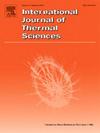Conduction-convection coupled heat and moisture transfer in the open-width pre-drying for elastic fabrics
IF 4.9
2区 工程技术
Q1 ENGINEERING, MECHANICAL
International Journal of Thermal Sciences
Pub Date : 2025-04-29
DOI:10.1016/j.ijthermalsci.2025.109963
引用次数: 0
Abstract
A novel open-width pre-drying scheme is presented in this study, which utilizes a large drum and hot air as dual heat sources for elastic fabrics. The aim is to prevent the migration of absorbed dye liquor at elevated temperatures and ensure that the elastic fabric attains optimal moisture content. This approach effectively addresses significant challenges in open-width drying, such as fabric deformation, curled edges, and the absence of specialized equipment. These issues have historically hindered the development and application of efficient drying technologies for elastic fabrics. To support this approach, a heat and mass transfer model is established to simulate the pre-drying process, incorporating moisture transfer within the fabric and the transitions between various moisture states. The model also defines boundary conditions based on the fabric's position within the pre-drying setup. The accuracy of the proposed model is validated against experimental data under various conditions, revealing maximum relative deviations of 34.7 % in moisture content and 2.2 % in temperature, along with high correlation coefficients of 0.99 and 0.96. This confirms effectiveness of the model in capturing moisture transfer and heat exchange dynamics during the pre-drying process. The drying process follows a three-stage pattern influenced by parameters such as drum temperature and fabric feed speed. It is recommended to maintain lower drum temperatures while ensuring higher jet temperature, and to optimize drying time by adjusting fabric feed speed. These insights are essential to enhancing drying efficiency and quality in the open-width pre-drying for elastic fabrics.
弹性织物开幅预干燥中的传导-对流耦合热湿传递
提出了一种利用大滚筒和热空气作为弹性织物双热源的开幅预干燥方案。目的是防止在高温下吸收染料液的迁移,并确保弹性织物达到最佳的水分含量。这种方法有效地解决了平幅干燥中的重大挑战,如织物变形、卷曲边缘和缺乏专门的设备。这些问题历来阻碍了弹性织物高效干燥技术的发展和应用。为了支持这种方法,建立了一个传热传质模型来模拟预干燥过程,包括织物内部的水分传递和各种水分状态之间的转换。该模型还根据织物在预干燥装置中的位置定义了边界条件。根据不同条件下的实验数据验证了该模型的准确性,结果表明,湿度和温度的最大相对偏差分别为34.7%和2.2%,相关系数分别为0.99和0.96。这证实了该模型在捕捉预干燥过程中的水分传递和热交换动力学方面的有效性。干燥过程遵循受滚筒温度和织物进料速度等参数影响的三个阶段模式。建议在保证较高射流温度的同时保持较低的滚筒温度,并通过调整织物进料速度来优化干燥时间。这些见解是必不可少的,以提高干燥效率和质量的开幅预干燥弹性织物。
本文章由计算机程序翻译,如有差异,请以英文原文为准。
求助全文
约1分钟内获得全文
求助全文
来源期刊

International Journal of Thermal Sciences
工程技术-工程:机械
CiteScore
8.10
自引率
11.10%
发文量
531
审稿时长
55 days
期刊介绍:
The International Journal of Thermal Sciences is a journal devoted to the publication of fundamental studies on the physics of transfer processes in general, with an emphasis on thermal aspects and also applied research on various processes, energy systems and the environment. Articles are published in English and French, and are subject to peer review.
The fundamental subjects considered within the scope of the journal are:
* Heat and relevant mass transfer at all scales (nano, micro and macro) and in all types of material (heterogeneous, composites, biological,...) and fluid flow
* Forced, natural or mixed convection in reactive or non-reactive media
* Single or multi–phase fluid flow with or without phase change
* Near–and far–field radiative heat transfer
* Combined modes of heat transfer in complex systems (for example, plasmas, biological, geological,...)
* Multiscale modelling
The applied research topics include:
* Heat exchangers, heat pipes, cooling processes
* Transport phenomena taking place in industrial processes (chemical, food and agricultural, metallurgical, space and aeronautical, automobile industries)
* Nano–and micro–technology for energy, space, biosystems and devices
* Heat transport analysis in advanced systems
* Impact of energy–related processes on environment, and emerging energy systems
The study of thermophysical properties of materials and fluids, thermal measurement techniques, inverse methods, and the developments of experimental methods are within the scope of the International Journal of Thermal Sciences which also covers the modelling, and numerical methods applied to thermal transfer.
 求助内容:
求助内容: 应助结果提醒方式:
应助结果提醒方式:


